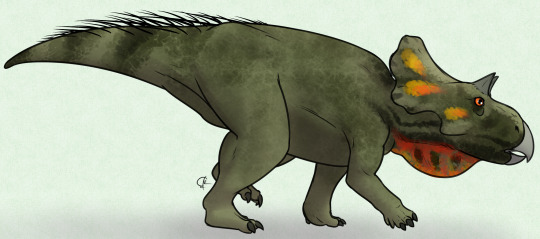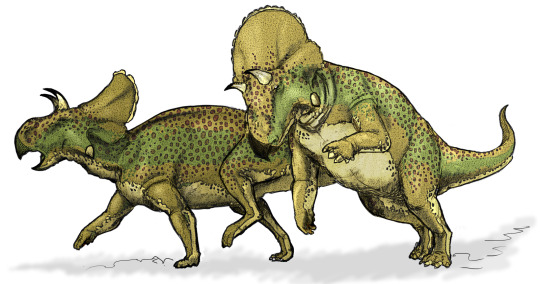#Coniornis
Explore tagged Tumblr posts
Text
Avaceratops lammersi

By José Carlos Cortés on @ryuukibart
PLEASE support us on Patreon! We really do need all of your support to keep this blog running - any amount helps!
Name: Avaceratops lammersi
Name Meaning: Ava Horned Face
First Described: 1986
Described By: Dodson
Classification: Dinosauria, Ornithischia, Genasauria, Neornithischia, Cerapoda, Marginocephalia, Ceratopsia, Neoceratopsia, Coronosauria, Ceratopsoidea, Ceratopsidae, Centrosaurinae, Nasutoceratopsini
Avaceratops is a Ceratopsian more closely related to Nasutoceratops than the ones we have been looking at, and this isn’t surprising, given it also still has the brow horns that were characteristic of the first Ceratopsids. Indeed, the Nasutoceratopsins were earlier derived than the other two major groupings of Centrosaurines, the Centrosaurins and the Pachyrhinosaurins. Avaceratops was approximately four meters long and was a fairly small Ceratopsid, with a long curving side to its frill, as well as a slight divide in the side of the frill’s shape. It also didn’t have fenestra in the frill, but rather a solid structure, indicating that it might not have had similar display features as other Ceratopsians, though it probably was used for display.

By Mariana Ruiz Villarreal, in the Public Domain
It was the first Ceratopsid named in thirty six years, the one preceding it being Pachyrhinosaurus. It is known from only the original specimen, which was probably a body scattered down a river. It was found, specifically, in the Judith River Formation in Montana, dating back to the Campanian age of the Late Cretaceous, approximately 77 million years ago. It lived in a heavily forested habitat, and probably ate primarily a diet of ferns, cycads, and conifers. It lived alongside many other dinosaurs, though it probably wasn’t a very common sight there, given it isn’t known from many remains. It lived alongside dinosaurs such as Brachylophosaurus, Judiceratops, Medusaceratops, Mercuriceratops, Probrachylohposaurus, Spiclypeus, Coniornis, Dromaeosaurus, Paronychodon, Troodon, and other, more dubious taxa.
Sources:
https://en.wikipedia.org/wiki/Avaceratops
https://en.wikipedia.org/wiki/Judith_River_Formation
Shout out goes to @missaraerae!
#avaceratops#avaceratops lammersi#dinosaur#ceratopsian#palaeoblr#paleontology#prehistory#prehistoric life#dinosaurs#biology#a dinosaur a day#a-dinosaur-a-day#dinosaur of the day#dinosaur-of-the-day#science#nature#factfile#missaraerae#Dìneasar#डायनासोर#ديناصور#ডাইনোসর#risaeðla#ڈایناسور#deinosor#恐龍#恐龙#динозавр#dinosaurio#공룡
31 notes
·
View notes